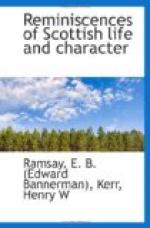a well-known character, a writer of Perth, to come
up and meet him at Dunkeld for the transaction of
some business. The Duke mentioned the day and
hour when he should receive the man of law, who accordingly
came punctually at the appointed time and place.
But the Duke had forgotten the appointment, and gone
to the hill, from which he could not return for some
hours. A Highlander present described the Perth
writer’s indignation, and his mode of showing
it by a most elaborate course of swearing. “But
whom did he swear at?” was the inquiry made
of the narrator, who replied, “Oh, he didna
sweer at ony thing particular, but juist stude in ta
middle of ta road and swoor at lairge.”
I have from a friend also an anecdote which shows
how entirely at one period the practice of swearing
had become familiar even to female ears when mixed
up with the intercourse of social life. A sister
had been speaking of her brother as much addicted
to this habit—“Oor John sweers awfu’,
and we try to correct him; but,” she added in
a candid and apologetic tone, “nae doubt it
is
a great set aff to conversation.” There
was something of rather an
admiring character
in the description of an outbreak of swearing by a
Deeside body. He had been before the meeting
of Justices for some offence against the excise laws,
and had been promised some assistance and countenance
by my cousin, the laird of Finzean, who was unfortunately
addicted to the practice in question. The poor
fellow had not got off so well as he had expected,
and on giving an account of what took place to a friend,
he was asked, “But did not Finzean speak for
you?” “Na,” he replied, “he
didna say muckle; but oh, he damned bonny!”
This is the place to notice a change which has taken
place in regard to some questions of taste in the
building and embellishing of Scottish places of worship.
Some years back there was a great jealousy of ornament
in connection with churches and church services, and,
in fact, all such embellishments were considered as
marks of a departure from the simplicity of old Scottish
worship,—they were distinctive of Episcopacy
as opposed to the severer modes of Presbyterianism.
The late Sir William Forbes used to give an account
of a conversation, indicative of this feeling, which
he had overheard between an Edinburgh inhabitant and
his friend from the country. They were passing
St. John’s, which had just been finished, and
the countryman asked, “Whatna kirk was that?”
“Oh,” said the townsman, “that is
an English chapel,” meaning Episcopalian.
“Ay,” said his friend, “there’ll
be a walth o’ images there.”
But, if unable to sympathise with architectural church
ornament and embellishment, how much less could they
sympathise with the performance of divine service,
which included such musical accompaniments as intoning,
chanting, and anthems! On the first introduction
of Tractarianism into Scotland, the full choir service
had been established in an Episcopal church, where




